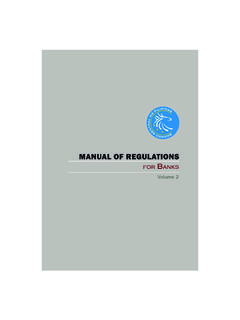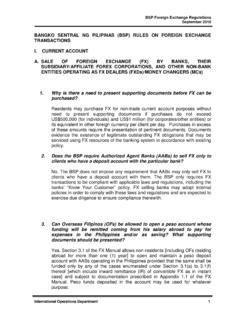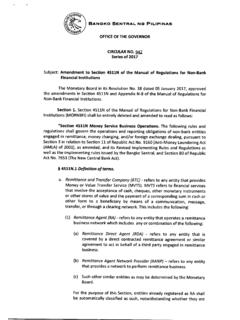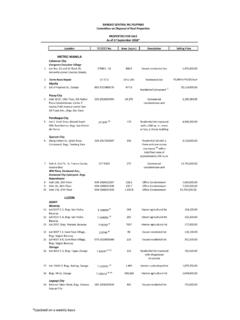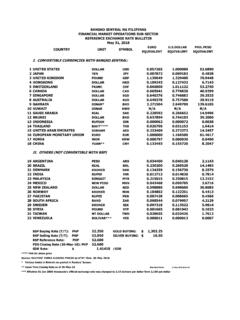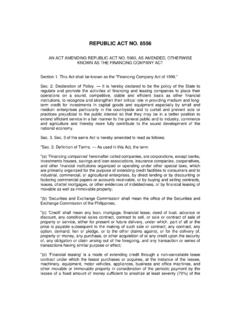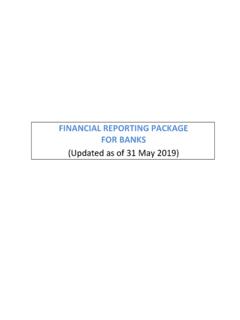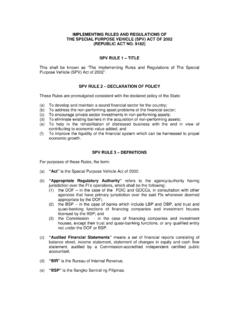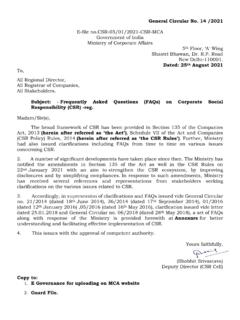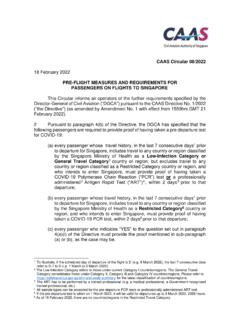Transcription of FREQUENTLY ASKED QUESTIONS ON CIRCULAR NO. 855
1 FREQUENTLY ASKED QUESTIONS ON CIRCULAR NO. 855 To facilitate the implementation of CIRCULAR No. 855 dated 29 October 2014 on the Guidelines on Sound Credit Risk Management Practices (Amendments to the Manual of Regulations for Banks and Non-Bank Financial Institutions) and to address various concerns related to the new CIRCULAR , the following answers to FREQUENTLY ASKED QUESTIONS are hereby issued: BACKGROUND The amended/enhanced guidelines seek to fundamentally strengthen credit risk management practices of financial institutions1 (FIs) and provide minimum set of operating standards that are consistent with BSP regulations and the Basel Core Principles for effective bank supervision. BSP expects FIs to adopt as part of their internal policy on credit risk management framework, sound policies and practices covering the following areas, as a minimum: a.
2 Establishing an appropriate credit risk environment b. operating under a sound credit granting process c. maintaining appropriate credit administration, measurement and monitoring process d. maintaining an appropriate control process CREDIT EVALUATION 1. Subsection on credit granting and loan evaluation/ analysis process and underwriting standards provides, in part that FIs may opt to use financial information/data from other sources . Does this mean that banks can use in-house financial information or financial information from sources other than audited financial statements submitted for tax purposes in their credit evaluation? Yes. In performing the financial analysis, FIs may use other financial information to support their decision; provided that appropriate safeguards are in place, and an evaluation of how much reliance or value was attached into the unaudited financial statements used is clearly articulated and documented in their internal policy.
3 2. In relation to question #1, can FIs opt not to obtain AFS/ITR stamped received by the BIR required under Subsection of the Manual of Regulations? 1 Banks and their credit-granting subsidiaries as well as stand-alone quasi-banks Page 2 of 6 No. FIs shall still obtain from borrowers and maintain on file updated Income Tax Returns (ITRs) duly stamped received by Bureau of Internal Revenue (BIR). FIs are given flexibility to determine to what extent the AFS will be used in credit decisions. SECURED LENDING 3. The collateral value was reduced to 60% of the appraised value of the property. What happens with the existing loans with 70% to 80% collateral values, will the remaining balance (portion not covered by collateral) be classified and provisioned?
4 No, so long as the FI has ascertained that the borrower has the capacity/cash flow and willingness to pay off the obligation. Classification depends on the performance of the loan, not on collateral. If the loan is performing and does not exhibit the characteristics prescribed in the FI s internal credit classification system, the loan will not be subject to classification. But a loan that is not performing, even if fully secured, will be subject to classification. Provisioning, on the other hand, will take into consideration the quality and realizable value of the collateral. Any short fall from the book value of the loan of its expected realizable value, net of collateral value, shall be covered by provisions. Consequently, the capping of collateral value at 60% may result in higher provisioning in the event loan does not perform as expected.
5 4. In the phrase by an appraiser acceptable to the BSP , who determines acceptability in the BSP? Does the BSP accredit appraisers? It is the responsibility of the FI to establish sound internal policy on the appraisal process ( , acceptance criteria for engagement of independent appraisers, when to utilize internal appraisers, under which conditions and for what purposes, what properties are acceptable, etc.) taking into account industry conventions and best practices. BSP will determine if FI has sound internal policy and whether FI adheres to such policy. If both conditions are fulfilled, BSP will respect FI s business decision. 5. Does the revised provision of Section X311 give FIs the liberty to assign collateral value for collaterals other than real estate? Yes, FIs are given the flexibility to assign value to collaterals other than real estate.
6 However, FIs should have reasonable internal policies, which are based on prudent standards, to cover the requirements of Section X311, to wit: the collateral has (1) an established market and (2) a sound valuation methodology ( , so long as the collateral can be easily disposed of or converted into cash). 6. Prior to CIRCULAR No. 855, merchandise inventory was considered as acceptable collateral. Will this type of collateral still be acceptable or should existing loans be now reclassified as unsecured? Page 3 of 6 Yes, so long as the FI has appropriate internal policies that cover the acceptance of merchandise inventory as collateral. The requirements of the acceptance of merchandise inventory as collateral should be covered by reasonable policies on having an established market, and soundness of valuation.
7 7. If land with improvement subject of REM is valued at P1 million (land only) but loan amount is significantly lower, , P100 thousand, would the bank be required to insure the improvement? If the realizable collateral value of the lot is already sufficient to cover the entire loan amount in the event of default, then it is not necessary to require insurance on the improvement. This is purely a business decision. LOAN LOSS PROVISIONING AND APPENDIX 18 OF MORB/MORNBFI2 8. Which FI may qualify to develop a loan-loss methodology? Ideally, all FIs should have/develop their loan-loss methodology appropriate to their credit business. Small FIs that think their credit operations may not justify to developing their own loan loss methodology, they may use a simplified approach described in the revised Appendix 18. FIs should note however that such simplified system may be quite conservative.
8 9. If an FI develops its loan-loss methodology (LLM), is it possible that the resulting ACL be lower than the figures generated using Appendix 18? Yes, that s precisely the incentive for an FI to invest in developing its own loan loss methodologies (LLM). It is critical, however, that the LLM is prudently designed ( , based on reasonable assumptions and supported by data). 10. If a loan is guaranteed by a government agency by say, up to 85% of outstanding balance, will it be acceptable to provide loan loss provisioning only for the remaining 15%? The amount of provisions will first and foremost depend on the performance of the loan. There s no need for specific provisions if the loan is performing. A financial guarantee provided by a government agency should be treated as nothing but a credit risk mitigant in the event the loan defaults.
9 For this purpose, its value as a credit risk mitigant will depend on the ability of the agency to cover the loan if the 2 Manual of Regulations for Banks/Manual of Regulations for Non-Banks Page 4 of 6 borrower defaults. FIs should have an internal policy in terms of acceptance of guarantees and an assessment on the value to attach to the guarantee. 11. Will the missed payment guidance for aging of accounts under Appendix 18 amend the definition of past due loans? Missed payment is reckoned against loan repayment schedule as agreed between the parties. A loan becomes past due if it misses scheduled payments. Loan classification and provisioning; however, depends on credit policy which should be prudent. 12. Will the grace period on loan payments be excluded in the determination of the reckoning date for missed payment?
10 Yes, if the grace period is: a) part of the design of the product to suit the expected cash flow stream; b) is clearly articulated in the board-approved credit policy; and c) not for the reason that the borrower is experiencing financial difficulty. 13. For loans with missed payments but with subsequent partial payment, would the number of days of missed payments accordingly be reduced? No. Determination of the number of days of missed payment is based on the full payment of amortization due (principal and interest). Primary consideration for the granting of loan is the borrower s ability to generate sufficient cash flow, and partial payment is a manifestation that the borrower is experiencing financial difficulty (even if this may just be temporary), thus, indicating that there may be a potential problem moving forward.
